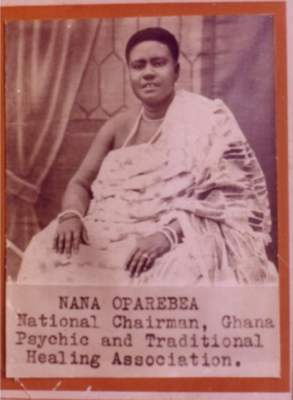-
Mema mo Adae tɔkye!
Awukudae (Wuku+adae) is the 10th ɛda (day) of the Adaduanan, and it is a dabɔne (holy day) that occurs when “Kuru” of the Nnanson (six-day week) intersects with “Wukuada” of the Nnawɔtwe (seven-day week).
“Adae” literally means “resting place in Twi, the language of the Akan. However within the Akan calendar system, Adaduanan, “adae” refers to either Akwesidae or Awukudae, which are the Akan’s two major holy days.
In Akan culture, Awukudae (Wuku+adae) is a holy day that occurs every 6 weeks where individuals divert from regular business and secular activities to feed and commune with the spirit of Aku/Wuku, as well as other Abosom (forces of nature) and Ancestors.
On this Awukudae, I’m focusing some particular attention and gratitude toward Nana Okomfohema Akua Oparebea.
Nana Oparebea was born in 1900 at Akwansu near Adawso, Eastern Region. Her father was an Asante man from the Asona clan living in Aburi, Eastern Region. Her mother was Ohemmea Aba Oyedi from the Amansᴐre family of Larteh. Nana Oparebea’s grandmother was Nana Amina, the second high priestess at the Akonnedi Shrine.
While she was yet a suckling, her aunt, Okomfo Amma Anima, professed under obosom possession that she would be an okomfo who would one day be an Okomfohema of the Akonedi shrine. Throughout each phase of her life, the prophecy of Okomfo Anima seemed to be materializing.
Nana Oparebea was trained by Nana Nkoma, the daughter of Okomfohema Adwo Komfo. After qualification and graduation, Nana Oparebea began her practice at Dobro. Later she moved to her father’s village, Nkukrom, and built a shrine for Akonnedi. People from far and wide, from all walks of life, came to her shrine for consultations and healing.
Her success as a businesswoman, property owner, and cocoa farmer helped her build the shrines and helped her establish the Akonnedi-affiliated shrines throughout Ghana. Oparebea was a disciplinarian and those who were obedient under her benefitted. Oparebea remains the “gold standard” among the priest community in Akuapem and throughout Ghana.
Nana Akua Oparebea was a multi-faceted and powerful priest. With her
close associations with Ghana’s first president, Kwame Nkrumah, and the Convention People’s Party, she was an astute cultural and political innovator.
Nkrumah appointed Nana Oparebea the inaugural president of Ghana Psychic and Traditional as a part of his Convention People’s Party (CPP) political agenda to organize traditional healing as a legitimate national ethno-medical institution to help Ghanaians and escape dependence on Western medicine.
Nkrumah became close friends with Nana Oparebea and subsequently built structures for her in the lower compound of Aburi. Thus, in many respects, Nana Oparebea’s, Aburi, was the First Republic of Ghana’s newly sanctioned and materially supported sacred spiritual space.
In 1965 on a solo trip to Ghana Africanist, photographer and master drummer Gus Dinizulu visited Nana Oparebea and the shrine with Mr. J.W. Amantefio, a boxing promoter and member of the Ghana Sports Council in Accra, the capital of Ghana. According to master herbalist and Tigare priest Numo Isaac Ahia of Accra, Dinizulu was searching for his ancestral roots. Through possession and divination, Nana Oparebea ascertained that Dinizulu was the descendant of her family who was stolen from them many years ago, captured, sold into slavery, and taken across the great waters. He had now returned home.
At that time, they charged Nana Dinizulu with finding and bringing back the lost children of Africa. Nana Oparebea performed the sacred spiritual rites for Nana Yao Opare Dinizulu. Thus began his journey in learning the ways of Akom – the spiritual practices of priests in Ghana. To aid him with his mission, Nana Oparebea prepared the shrines of Nana Asuo Gyebi, Nana Esi Ketewa, and Nana Adade Kofi, which he brought back to America. Nana Oparebea opened the doors of her shrines and gave Nana Dinizulu his first introduction to the beliefs and rituals of the Akan people. To her credit, Nana Oparebea defied the common belief that the shrines would not cross the “waters” (ocean). In 1967, Nana Dinizulu formed the spiritual organization of Bosum-Dzemawodzi to restore the Akan cultural legacy lost to Africans in America thus providing a framework for recapturing culture and identity.
Sources:
-
Amoako, H. K. (2020, December 11). Origin of the Akonedi Shrine: The Story of AkuaOparebea. African Research Consult. https://african-research.com/research/traditional-religion/origin-of-the-akonedi-shrine-the-story-of-akua-oparebea/
-
https://akancenter.org/wp-content/themes/NativeChurch-child/pdf/Akom-Kese-Journal-2016.pdf
-
Gye Nyame Newsletter vol. 1 December 2011. (2011, December 17). Issuu. https://issuu.com/dinizulu/docs/gye_nyame_new/12 by Ohema Afua Dinizulu
-
Boakyewa, O. (2016). OKOMFO AMA BADU BOAKYEWA. ABSTRACT. Dissertation. 2.2.2014. Umbc. https://www.academia.edu/27870735/OKOMFO_AMA_BADU_BOAKYEWA_ABSTRACT_Dissertation_2_2_2014
-



